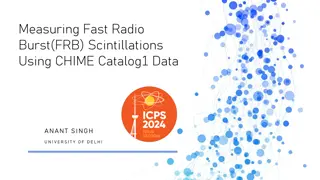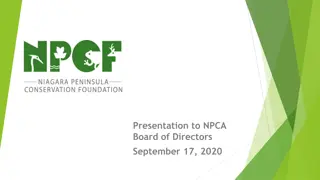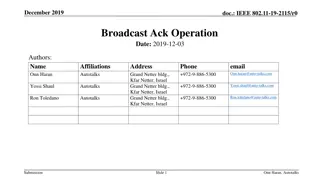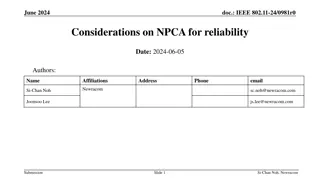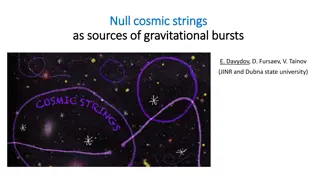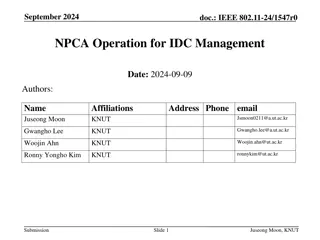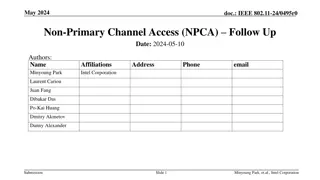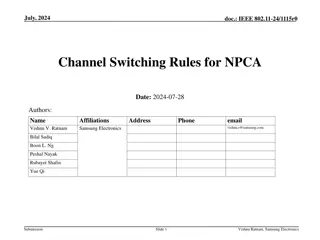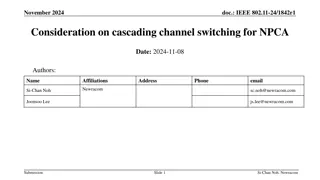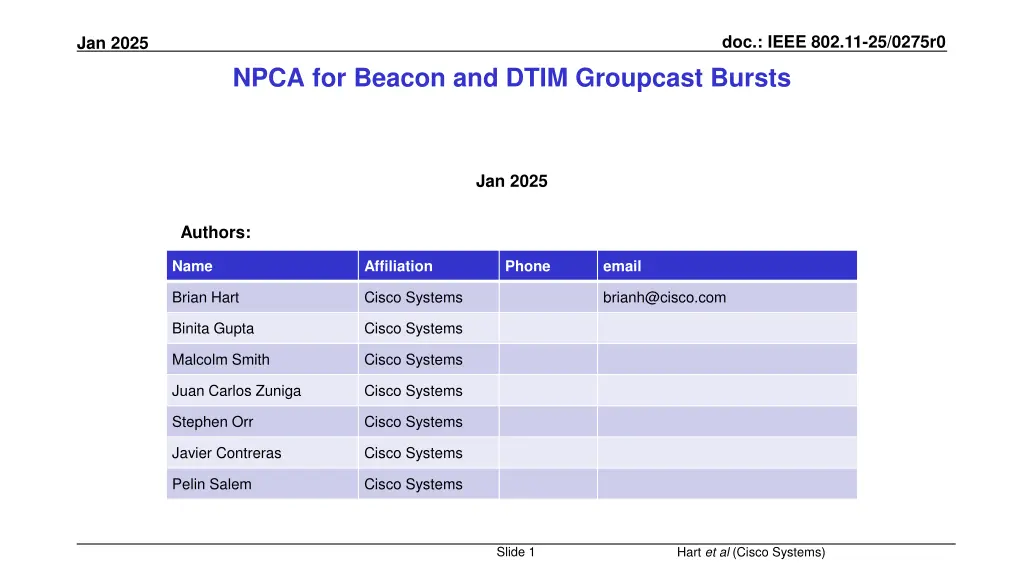
Enhancing IEEE 802.11 Networks with NPCA for Efficient Beacon and Groupcast Traffic Management
In this document released in January 2025 by authors from Cisco Systems, the use of NPCA (Non-Primary Channel Access) for managing Beacon and Groupcast bursts in IEEE 802.11 networks is highlighted. The document discusses the scenarios where NPCA can be implemented, the significance of NPCA in handling secondary channel access during busy primary channel conditions, and the challenges associated with optimizing NPCA efficiency. With insights into Beacon and DTIM Groupcast traffic patterns and the need for enhanced communication between APs and OBSS STAs, this document sheds light on advanced networking strategies to improve wireless network performance.
Download Presentation

Please find below an Image/Link to download the presentation.
The content on the website is provided AS IS for your information and personal use only. It may not be sold, licensed, or shared on other websites without obtaining consent from the author. If you encounter any issues during the download, it is possible that the publisher has removed the file from their server.
You are allowed to download the files provided on this website for personal or commercial use, subject to the condition that they are used lawfully. All files are the property of their respective owners.
The content on the website is provided AS IS for your information and personal use only. It may not be sold, licensed, or shared on other websites without obtaining consent from the author.
E N D
Presentation Transcript
doc.: IEEE 802.11-25/0275r0 Jan 2025 NPCA for Beacon and DTIM Groupcast Bursts Jan 2025 Authors: Name Affiliation Phone email Brian Hart Cisco Systems brianh@cisco.com Binita Gupta Cisco Systems Malcolm Smith Cisco Systems Juan Carlos Zuniga Cisco Systems Stephen Orr Cisco Systems Javier Contreras Cisco Systems Pelin Salem Cisco Systems Slide 1 Hart et al (Cisco Systems) -
doc.: IEEE 802.11-25/0275r0 Jan 2025 Situation (1/2) SFD defines limited circumstances under which NPCA can be performed [1] TGbn defines a mode of operation that enables a STA to access the secondary channel while the primary channel is known to be busy due to OBSS traffic or other TBD conditions. The event that triggers switching to the NPCA primary channel shall be OBSS Control frame exchange (e.g., (MU-)RTS/CTS) or OBSS HE/EHT/UHR PPDU Note: Other conditions TBD Slide 2 Hart et al (Cisco Systems) -
doc.: IEEE 802.11-25/0275r0 Jan 2025 Situation (2/2) Bursts of Beacon and DTIM Groupcast traffic are prime opportunities for NPCA Multiple SSIDs is common in the enterprise (and now the home) to support clients with credentials for different networks / different security capabilities / different levels of criticality, etc Beacons can contain multiple hundreds (and exceed 1000) of octets so lasts 0.5-1 msec at low MCSs Groupcast is becoming relatively common (e.g., due to mDNS announcements) APs may allow tens of TUs of groupcast per DTIM if the groupcast load is offered Beacons and DTIM groupcast are typically sent at 20 MHz In many deployments, AP density is favored for performance (rather than non-HT dup beacons for range) The first Beacon of a Colocated BSSID Set is typically sent at PIFS, then subsequent Beacons are typically sent after a similarly short xIFS Each Beacon does not protect subsequent Beacons (i.e., Duration equals 0) Each groupcast frame in a PPDU is typically transmitted after a short backoff such as AIFSN[VO] Each groupcast frame does not protect subsequent groupcast frames (i.e., Duration equals 0) The final groupcast frame is sent with EOSP = 1 so PM=1 clients can revert to sleep Non-AP STAs have generally learnt to not transmit during these Beacon + groupcast bursts due to the high likelihood of collision Slide 3 Hart et al (Cisco Systems) -
doc.: IEEE 802.11-25/0275r0 Jan 2025 Problem This large opportunity for NPCA is not disclosed outside the AP The AP knows exactly how many frames, their lengths, MCSs and inter-PPDU spacing that it is about to transmit. That is, the AP knows the minimum duration of this burst Since the Duration field is 0 in each Beacon and groupcast frame, this appears as many short NPCA opportunities to OBSS STAs. OBSSs seeking to use NPCA will need to NPCA switch-and-return 1-2-5-10-20-50-100 times during the Beacon and groupcast burst instead of a single switch-and-return NPCA opportunities with switch-and-return NPCA opportunities if the burst length is known P20 E E E E E E = EOSP per (M)BSSID indicating when (M)BSS groupcast burst ends so PM=1 STAs can revert to sleep (MBSSID) Beacons DTIM Groupcast Duration known to AP (but never signaled up front) Slide 4 Hart et al (Cisco Systems) -
doc.: IEEE 802.11-25/0275r0 Jan 2025 Solution (1/2) This large opportunity for NPCA should be disclosed by the AP, early in the Beacon + DTIM groupcast burst; better container options are Container Option A: AP transmitting many xIFS-spaced beacons and/or much groupcast after the beacon indicate this as early as possible to help NPCA STAs (but not so easy). Least-worst option, with strong backwards compatibility, is: In Type+Subtype fields, indicate Beacon-ness In Capabilities Information field (fixed field at order #3), indicate if this Beacon is part of a long Beacon + DTIM groupcast burst (e.g., 3x longer than remainder of this Beacon frame) A few bits in the Extended Capabilities element (else a new element at near the end of the Beacon frame) to indicate the remaining duration of the long Beacon + DTIM groupcast burst Container Option B: As a field (T) in an ICF sent before the first Beacon in a long Beacon + DTIM groupcast burst This works, but adds wireless overheads of no help to the transmitting AP therefore the sending of this ICF should be enabled as part of a MAPC agreement with an OBSS AP that has NPCA activated T ICF(T) E E E E E (MBSSID) Beacons DTIM Groupcast Slide 5 Hart et al (Cisco Systems) -
doc.: IEEE 802.11-25/0275r0 Jan 2025 Solution (2/2) Encodings Various familiar encodings are possible: Units of 1 / 4 / 8 / 32 / 64 / 128 sec or more E.g., ceil(log2(50 TU / 128 sec)) = 9 bits Piecewise-linear variants Such as in the TXOP field in USIG (with pieces incrementing at ~4 sec then ~64 sec): 7 bits But limited to 8575 sec 9-bit version of this: covers up to 33151 sec Power of two versions better suited to the Extended Capabilities element E.g., 0.25, 0.5, 1, 2, 4, 8, 16, 32 TUs: 3 bits All use rounding down Slide 6 Hart et al (Cisco Systems) -
doc.: IEEE 802.11-25/0275r0 Jan 2025 FAQs Q: Will this delay time to value since it requires the OBSS AP to be a UHR AP A: Certainly not in the enterprise. Almost always the venue upgrades all APS in a floor (or in a building) at the same time Q: Does this enable a new DoS attack(?): AP with beacon + DTIM sends this control frame, which causes UHR OBSS NPCA STAs off channel (perhaps for longer than a TXOP duration), then the AP cancels its NAV and the BSS enjoys reduced-congestion channel access. Meanwhile the non-NPCA OBSS STAs see a clear channel, can t communicate with their AP and drop traffic / disconnect A: This attack is available even without the control frame (ICF + <short transmission(s)> + CF-End (up to the max TXOP duration) All MAPC features between administrative domains require policing. This style of attack can be detected by the AP randomly delaying its NPCA channel switch (and/or enterprise APs have scanning radios and can trivially detect this attack; monitoring BA holes, etc) Attack is disallowed under Part 15 rules and WFA Extensions Policy so won t be adopted by major vendors Disconnection is improbable given that the timeout is multiple BIs Then sufficient mitigation is a) a BSS-wide field to enable/disable consuming the control frame and/or b) limiting each control frame s duration to a TXOP limit. Q: How long are DTIM + groupcast bursts? A (partial): Typically, higher education has 4- 8 SSIDs (and then 4-8 beacons in a row each > 0.5 msec) Typically, carpeted enterprise enterprise has 2-4 SSIDs Groupcast is highly variable Slide 7 Hart et al (Cisco Systems) -
doc.: IEEE 802.11-25/0275r0 Jan 2025 Summary There are great opportunities for NPCA during bursts of Beacons and DTIM groupcast Also, for power save by OBSS non-AP STAs But these opportunities are presently hard to harvest given the disjoint Duration fields And the disjoint Duration fields during the groupcast is a feature; this enables OBSS APs to transmit their beacons Instead, we need additional early signaling to indicate the burst duration Least-worst option seems to be an ICF before a longer Beacon and DTIM groupcast burst Enabled after MAPC negotiation Slide 8 Hart et al (Cisco Systems) -
doc.: IEEE 802.11-25/0275r0 Jan 2025 Strawpoll 1 Do you agree to add the following text to the 11bn SFD: UHR defines how APs can signal a long burst of Beacons and DTIM groupcast; and recipient OBSS NPCA STAs can use this as another event to pivot to the NPCA primary channel NOTE: signaling examples include a) fields in an ICF at the burst start, and b) fields in the Beacon frames Y / N / A Slide 9 Hart et al (Cisco Systems) -
doc.: IEEE 802.11-25/0275r0 Jan 2025 References [1] 24/209r8 Specification Framework for TGbn , Ross Jian Yu Slide 10 Hart et al (Cisco Systems) -
doc.: IEEE 802.11-25/0275r0 Jan 2025 Backup Slide 11 Hart et al (Cisco Systems) -
doc.: IEEE 802.11-25/0275r0 Jan 2025 Solution Backup (1/2) Mostly dead-ends for how an AP might signal a long DTIM Beacon + groupcast burst Various containers can be considered: Beacons are typically sent as non-HT, with no BSS Color, USIG or spare SIGNAL bits HE is allowed in 6 GHz, but still no USIG field; and reserved bits may not be available in reality These are Beacons so it is intolerable for a change to introduce reception failures at legacy; which likely rules out: Signaling using LSIG side carriers ( 27, 28) Service field (especially at 2.4/5 GHz) If NPCA STAs waited on all beacons, but the current received Beacon was just a single Beacon with no groupcast, most of the NPCA gains would be lost if the signaling is near the end of the Beacon, which likely rules out: New element in Beacon (which would be near the end) The Pad bits at the end of the non-HT Data field Extended Capabilities element is a maybe; but, at position #37 it is far from the beginning Control frame before the groupcast but if there, why not before both beacons and groupcast? NPCA STAs sniff beacons, learn the pattern of BSSIDs (number and length of beacons, when DTIM beacons occur, typical groupcast length) but NPCA relies on STAs pivoting to the NPCA primary channel at much the same time which this does not provide for. APs could do this classification work and publish it to their BSSs but seems complicated Slide 12 Hart et al (Cisco Systems) -
doc.: IEEE 802.11-25/0275r0 Jan 2025 Solution Backup (2/2) No need for two fields FAQ: Why not two time fields: One for Beacon burst duration One for (Beacon burst duration +) Groupcast duration since this could increase the opportunity for OBSS non-AP STAs to doze? A: Assuming success with Colocated Co-TDMA, the Beacons Duration field could reasonably be expanded to cover all the beacon frames in the beacon burst. Only if this is unsuccessful should we revisit the question of two distinct time fields Slide 13 Hart et al (Cisco Systems) -


